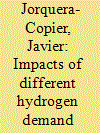|
|
|
Sort Order |
|
|
|
Items / Page
|
|
|
|
|
|
|
| Srl | Item |
| 1 |
ID:
188555


|
|
|
|
|
| Summary/Abstract |
With expanding solar and wind power production, the topic of flexibility services attracts increased attention in the Swedish energy system. In this context, the potentials in using thermal storage capacities in district heating (DH) systems have been brought forward, primarily by academic scholars. Using a ‘grounded’ approach, this study investigates if professionals assigned to Swedish DH companies and electricity distribution system operators utilise, or plan to utilise, DH systems as flexibility services for the electricity grid. Original data was collected through semi-structured interviews, held with fourteen individuals affiliated to different actors in the Swedish energy system. These individuals were identified as being experts, or practically engaged, in using DH utilities as flexibility services for the electricity grid. The findings show that although technologies for coupling between DH systems and the electricity grid are already in place, initiatives for using DH systems as flexibility services for the electricity system are rare in Sweden. Coupling challenges stem from ownership and operation legislation frameworks, marginal incentives and a widespread focus on firm benefits rather than energy systems benefits. Identified initiatives for using DH systems for flexibility services are primarily run on a local scale, designed and propelled by small groups of engaged individuals.
|
|
|
|
|
|
|
|
|
|
|
|
|
|
|
|
| 2 |
ID:
177507


|
|
|
|
|
| Summary/Abstract |
Energy Systems Integration (ESI) is an emerging paradigm and at the centre of the EU energy debate. ESI takes a holistic view of the electricity, gas, and heat sectors to deliver a clean, reliable, and affordable energy system. By using the synergies within and between sectors, ESI aims to increase flexibility in the energy system, maximise the integration of renewable energy and distributed generation, and reduce environmental impact. While ESI-enabling technologies have been studied from a technical perspective, the economic, regulatory, and policy dimensions of ESI are yet to be analysed in depth. This paper discusses ESI in a multi-step approach. We first focus on the economics of ESI-enabling technologies. Then we briefly discuss how the EU national regulators incentivise their adoption. Major economic and policy barriers to ESI are identified and policy solutions to overcome these barriers are proposed. We conclude that current regulatory frameworks in the EU do not sufficiently stimulate ESI investments and only through proper design of incentives ESI can be adopted.
|
|
|
|
|
|
|
|
|
|
|
|
|
|
|
|
| 3 |
ID:
177101


|
|
|
|
|
| Summary/Abstract |
Sector coupling (SC) describes the concept of a purposeful connection and interaction of energy sectors to increase the flexibility of supply, demand, and storing. While SC is linked to research on smart energy system and locates itself in the research stream of 100% renewable energy systems, it currently focusses on counteracting challenges of temporal energy balancing induced by the intermittent feed-in of renewable energy sources. As regarding the coupling of grids, SC currently remains within classical energy grids. It does not exploit the coupled sectors’ potential to its full extent and, hence, lacks a holistic view. To include this view, we call on the use of all grids from coupled sectors for spatial energy transportation, resulting in an infrastructural system. By using the different loss structures of coupled grids, we illustrate how a holistic view on SC minimizes transportation losses. We argue that SC should include all grids that transport whichever type of energy (e.g., even transportation or communication grids). Ultimately, we derive and discuss implications relevant for policy makers and research: We illustrate why regulation and market design should be aligned in a way that the resulting incentives within and across the different sectors support climate change goals.
|
|
|
|
|
|
|
|
|
|
|
|
|
|
|
|
| 4 |
ID:
192707


|
|
|
|
|
| Summary/Abstract |
As countries continue to update their climate ambitions, they are seeking cost-effective solutions for decarbonizing energy use. In this context, low-carbon hydrogen production and use presents relevant opportunities for emissions reductions and economic development, and recent studies show important potential benefits from integrating electricity and hydrogen networks. Based on a novel mathematical optimization model, we conduct a case study for Chile in 2020–2050 to assess the least-cost evolution of the integrated hydrogen–electricity system, testing different carbon prices, 100% renewable mandates, and incorporating domestic and international hydrogen demand. By optimizing over various scenarios, we find that, due to the country’s significant renewable potential and the flexibility that electrolyzers can provide, adding hydrogen exports to domestic hydrogen use may enhance renewable integration, while not necessarily increasing average wholesale electricity prices for typical end-users (relative to our baseline scenario), but also make battery deployment unattractive. Further, we conclude that climate policies such as a high carbon price or a 100% renewable mandate may be crucial to achieve a fully renewable system by 2050 and reduce cumulative emissions, resulting in 3%–14% higher net present system costs. Finally, we discuss that various concerns such as water and land use must be addressed by policymakers.
|
|
|
|
|
|
|
|
|
|
|
|
|
|
|
|
|
|
|
|
|